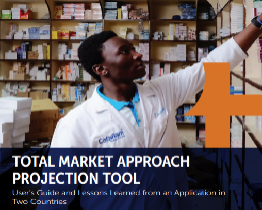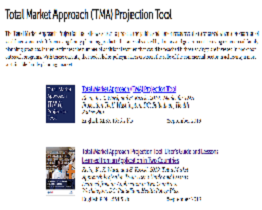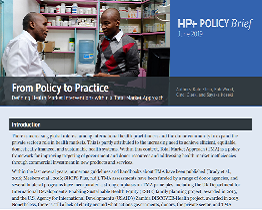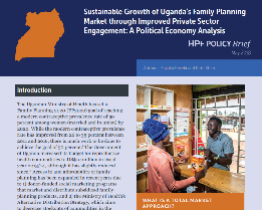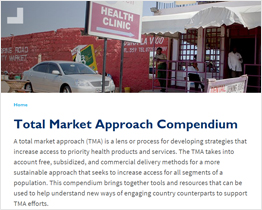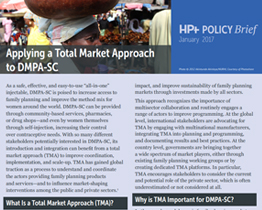Country Case Study – Kenya
In Kenya, donor funding support for family planning is dwindling, with an identified commodity gap of US$7.2 million in 2016. It is also not clear what proportion of the market for family planning is covered by the private sector. To better understand the market for family planning, the Ministry of Health with support from the Enabling Sustainability Health Equity (ESHE) project in Kenya adopted a TMA framework in 2016 to engage key stakeholders in the country including private sector players, and to conduct a family planning market analysis. The analysis revealed that approximately 6 percent of users obtained their family planning from the commercial sector—significantly larger than the 1 percent of users that was previously believed. The findings from this analysis were used as the basis for advocacy messages to actively engage and convene a meeting of commercial sector partners (for-profit manufacturers and distributors) in Kenya’s family planning market. Information from this analysis has now been incorporated into the country’s family planning forecasting and quantification process, and has reduced the 2016-17 annual family planning funding gap by more than US$1 million. Furthermore, the commercial sector is now more engaged in Ministry of Health-led forecasting and planning process.
A total market approach (TMA) is when public and private players coordinate to jointly meet the healthcare needs of a population and leverage the strengths of each player to maximize the reach and quality of services. In many developing countries, segments of the population use the private sector for their healthcare needs. The private sector is a diverse group that includes individual clinics operated by doctors, nurses, or midwives, as well as hospitals, drug shops, and pharmacies. These providers can be for profit, not for profit, or faith-based organizations.
While there is no clear evidence that the quality of services offered through the private sector is better or worse than those provided by the public sector across countries, private sector clients may enjoy benefits such as closer geographic access and more convenient hours of operation. Also, compared to the public sector, which tends to operate a “one-size-fits-all” model to serve anyone that comes through the door, the private sector has the flexibility to cater to its desired segments of the population (e.g., those with more ability to pay, youth, pregnant women), customizing its infrastructure, human resources, and services to fit their clients’ needs. Since private sector success is based on increased demand for services, private providers may be more likely than public providers to conduct innovative approaches to improve their services and adopt and scale services that are in high demand.
Many countries have an established and growing private health sector. Partnering with and leveraging the capacity of the private sector is thus an important avenue for expanding the resource envelope and increasing access to essential health services. By better understanding the market segments of the population, often by their willingness and ability to pay, the private sector could serve those with the ability to pay, while the public sector and donor-funded programs target their resources toward those who cannot pay.
However, the market for private sector services is generally fragmented and lacks coordination with the government. The government often does not have a full understanding of the private sector, or mechanisms in place to effectively engage with it, which can lead to public- and donor-funded programs competing with the private sector. Effective regulations to ensure quality while enhancing opportunities for the private sector are limited. A TMA is an evidence-based process to overcome these barriers for all market players to coordinate and collaborate for a mutually beneficial goal, often stewarded by the public sector.
What Is a Total Market Approach?
TMA aims to improve access, equity, and sustainability of healthcare by accounting for and maximizing the contribution of all public and private players in the market. It identifies market players; understands how they can contribute to improved access to information, products, and services; and implements market interventions to enable the total market to grow. Coordination is the hallmark of successful TMA process, and often the public sector plays a vital role in stewarding this process. Therefore, first and foremost, the awareness raising and advocacy for TMA within the public sector is critical in ensuring that TMA is implemented effectively and sustainably.
TMA is applicable to most countries because it helps address health inequities, public-sector constraints, and lack of clarity on how the private sector can engage in partnerships with the public sector. There are multiple frameworks to guide applications of TMA; however, all emphasize the need to convene stakeholders, gather and generate evidence on market dynamics, and form plans and policies that leverage each sector’s comparative advantages to reach different types of clients with a range health service offerings.
Why Is TMA Important for Family Planning?
Like many health services in developing countries, there is a gap between the demand and supply of family planning products and services, making the family planning market inefficient. This means family planning prices may be distorted and people unable to access needed services. For example, some public sector facilities may not have sufficient commodities to meet clients’ family planning needs despite their clients’ ability to pay. Similarly, private providers in closer proximity to the community in need of family planning are not integrated into government or donor-funded training opportunities, so they may not be able to offer a comprehensive package of family planning services and products. Closing the inefficiency gap requires the effective engagement of the private sector. However, funding for family planning programs has historically been dominated by donors, which has led to most products being available for free or at a subsidized price. Thus, the commercial sector (a for-profit subset of the private sector) has little incentive to actively engage in the market for family planning products and services. As a result, the wealthier segments of the population have limited options through which to access family planning and relies on the public sector for subsidized services. This situation leads to limited access for the poorer segments of the population and reinforces inequities in the healthcare system.
If there were coordination between the public and private sectors, and a policy-enabling environment that fostered the growth of the private sector, limited government and donor resources could be better targeted to poor and hard-to-reach populations. Figure 1 illustrates how TMA could improve market segmentation, leading to reduced unmet need and better use of limited resources. For example, if TMA results in an expanded commercial sector and wealthier women accessed family planning services in this sector, there could be more room within existing resources for less wealthy women to access family planning services for free or at low cost in the public sector. As such, TMA is an important strategy for shifting the family planning market to a more rational, balanced, and sustainable model. When implemented successfully, TMA can lead to:
-
Improved coordination: understanding who is doing what and where in the family planning market
-
Increased fiscal space: understanding how to expand the resource envelope for family planning through contributions from each market player, particularly the private sector
-
Increased efficiency: understanding how to make the best use of the resources available to reach the largest number of people needing family planning services
-
Increased equity: understanding how to provide family planning services to underserved and difficult-to-reach groups
TMA can provide better access for clients and contribute to higher modern contraceptive prevalence rates, lower levels of fertility, and ultimately better population-level health.
Resources
The Total Market Approach Projection Tool allows a user to project the public and donor resources that are saved when a proportion of wealthier
The Total Market Approach Projection Tool allows a user to project the public and donor resources that are saved when a proportion of wealthier
This brief supports governments, donors, and TMA practitioners in identifying concrete market interventions that they can implement to address
To provide a more thorough understanding of the political and economic dynamics affecting implementation of a robust total market approach in


